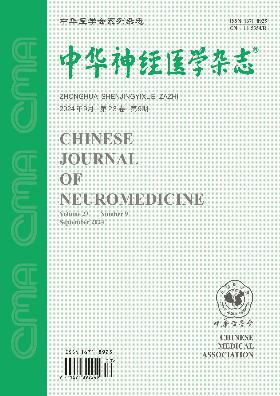Correlations of serum level of thyroid-stimulating hormone with tumor necrosis factor-α, lipoprotein associated phospholipase A2 and interleukine-6 levels in ischemic stroke patients with subclinical hypothyroidism
Q4 Medicine
引用次数: 0
Abstract
Objective To evaluate the correlations of serum level of thyroid-stimulating hormone (TSH) with levels of inflammatory factors lipoprotein associated phospholipase A2 (Lp-PLA2), tumor necrosis factor-α (TNF-α) and interleukine (IL)-6 in ischemic stroke (IS) patients with subclinical hypothyroidism (SCH) and its clinical significance. Methods Twenty SCH patients, 30 IS patients and 30 IS+SCH patients, admitted to our hospital from October 2017 to October 2018, were enrolled in our study; 27 subjects underwent physical examination in our hospital at the same period were selected as the control group. The serum levels of TSH, Lp-PLA2, TNF-α and IL-6 were measured by up-converting phoshor assay and enzyme - linked immunosorbent assay with double antibody sandwich. The common carotid artery, internal carotid artery and vertebral artery were examined by Doppler ultrasonography to analyze the morphology, location, and echo characteristics of the plaques and stenosis rates. Pearson correlation analysis was used to analyze the correlations of TSH with inflammatory factors, carotid artery stenosis rate. Results The levels of Lp-PLA2, TNF-α and IL-6 in IS+SCH group were significantly higher than those in SCH group, IS group and control group (P<0.05); those in the SCH group and IS group were significantly higher than those in the control group (P<0.05). The serum TSH levels in IS+SCH group and SCH group were positively correlated with Lp-PLA2 level (r=0.739, P=0.000; r= 0.697, P=0.000), TNF-α level (r=0.981, P=0.000; r=0.723, P=0.000) and IL-6 level (r=0.859, P=0.000; r=0.583, P=0.000); but the serum TSH levels in IS group and NC group were not correlated with Lp-PLA2 level (r=0.223, P=0.236; r=0.249, P=0.210), TNF-α level (r=0.304, P=0.103; r=0.056, P=0.780) and IL-6 level (r=0.027, P=0.887; r=0.138, P=0.491). The number of unstable plaques and degree of stenosis in IS+SCH group were larger/higher than those in IS group, SCH group and control group (P< 0.05); there was a positive correlation between serum TSH level and artery stenosis rate (r=0.739, P= 0.000). Conclusion SCH may lead to occurrence and development of atherosclerosis by increasing the serum levels of TNF-α, Lp-PLA2 and IL-6 caused by low-level chronic inflammation, which in turn increases the risk of ischemic stroke. Key words: Ischemic stroke; Subclinical hypothyroidism; Thyroid-stimulating hormone; Lipoprotein associated phospholipase A2; Tumor necrosis factor-α; Interleukin-6缺血性脑卒中合并亚临床甲状腺功能减退患者血清促甲状腺激素水平与肿瘤坏死因子-α、脂蛋白相关磷脂酶A2及白细胞介素-6水平的相关性
目的探讨缺血性脑卒中(IS)合并亚临床甲状腺功能减退(SCH)患者血清促甲状腺激素(TSH)水平与炎症因子脂蛋白相关磷脂酶A2 (Lp-PLA2)、肿瘤坏死因子-α (TNF-α)、白细胞介素(IL)-6水平的相关性及其临床意义。方法选取2017年10月~ 2018年10月我院收治的SCH患者20例、IS患者30例、IS+SCH患者30例;选取同期在我院体检的受试者27例作为对照组。采用上转化磷光法和双抗体夹心酶联免疫吸附法检测血清TSH、Lp-PLA2、TNF-α和IL-6水平。应用多普勒超声检查颈总动脉、颈内动脉和椎动脉,分析斑块的形态、位置、回声特征及狭窄率。采用Pearson相关分析TSH与炎症因子、颈动脉狭窄率的相关性。结果IS+SCH组血清Lp-PLA2、TNF-α、IL-6水平显著高于SCH组、IS组和对照组(P<0.05);SCH组和IS组均显著高于对照组(P<0.05)。IS+SCH组和SCH组血清TSH水平与Lp-PLA2水平呈正相关(r=0.739, P=0.000;r = 0.697, P = 0.000),肿瘤坏死因子-α水平(r = 0.981, P = 0.000;r=0.723, P=0.000)和IL-6水平(r=0.859, P=0.000;r = 0.583, P = 0.000);IS组和NC组血清TSH水平与Lp-PLA2水平无相关性(r=0.223, P=0.236;r = 0.249, P = 0.210),肿瘤坏死因子-α水平(r = 0.304, P = 0.103;r=0.056, P=0.780)和IL-6水平(r=0.027, P=0.887;r = 0.138, P = 0.491)。IS+SCH组不稳定斑块数量和狭窄程度均大于或高于IS组、SCH组和对照组(P< 0.05);血清TSH水平与动脉狭窄率呈正相关(r=0.739, P= 0.000)。结论SCH可能通过提高低水平慢性炎症引起的血清TNF-α、Lp-PLA2和IL-6水平,从而增加缺血性脑卒中的发生发展。关键词:缺血性脑卒中;亚临床甲状腺功能减退;促甲状腺激素;脂蛋白相关磷脂酶A2;肿瘤坏死因子-α;白细胞介素- 6
本文章由计算机程序翻译,如有差异,请以英文原文为准。
求助全文
约1分钟内获得全文
求助全文
来源期刊

中华神经医学杂志
Psychology-Neuropsychology and Physiological Psychology
CiteScore
0.30
自引率
0.00%
发文量
6272
期刊介绍:
 求助内容:
求助内容: 应助结果提醒方式:
应助结果提醒方式:


